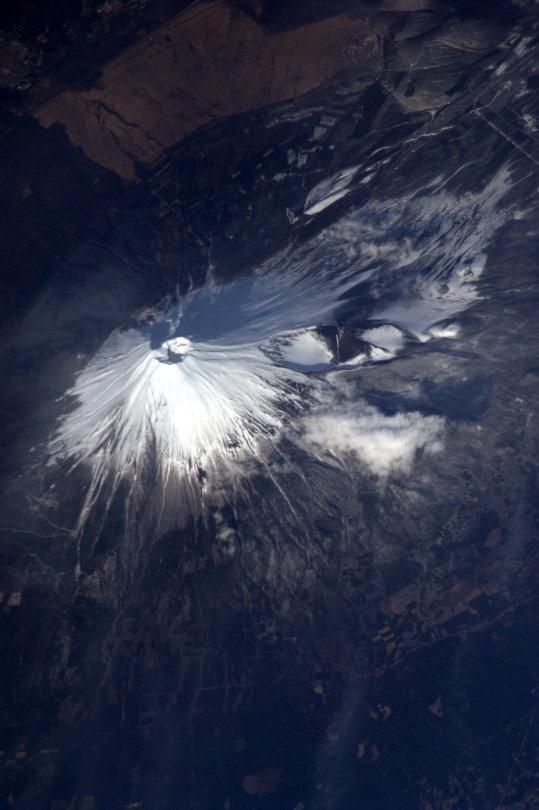Solar - Blog Posts

IBM solar collector magnifies sun by 2,000x (without cooking itself), costs 3x less than similar systems
Cleverly combining solar PV with solar thermal to reach 80% conversion efficiency
Concentrating the sun’s ray onto solar photovoltaic (PV) modules requires walking the fine line between optimizing power output and not literally melting your very expensive super-high-efficiency solar cells. A team led by IBM Research seems to have found a way to push back the line. They have created a High Concentration PhotoVoltaic Thermal (HCPVT) system that is capable of concentrating the power of 2,000 suns onto hundreds of triple junction photovoltaic chips measuring a single square centimeter each (they even claim to be able to keep temperatures safe up to 5,000x). The trick is that each solar PV cell is cooled using technology developed for supercomputers; microchannels inspired by blood vessels but only a few tens of micrometers in width pipe liquid coolant in and extract heat “10 times more effective than with passive air cooling.”

Waste not
The beauty is that this heat is not just thrown away. This system gets useful work out of it. So while the PV modules are 30%+ efficient at converting the sun’s light into electricity, another 50% of the sun’s energy is captured as heat and can then be used to do things like thermal water desalination and adsorption cooling. This means that the system is capable of converting around 80% of the collected solar energy into useable energy (though the electricity is of course more useful than the thermal energy).

A single collector can produce about 25 kilowatts of electricity. Below is a closeup of some PV cells where the light is being concentrated. Notice the piping to bring the liquid coolant.
"The design of the system is elegantly simple," said Andrea Pedretti , chief technology officer at Airlight Energy. "We replace expensive steel and glass with low cost concrete and simple pressurized metalized foils. The small high-tech components, in particular the microchannel coolers and the molds, can be manufactured in Switzerland with the remaining construction and assembly done in the region of the installation. This leads to a win-win situation where the system is cost competitive and jobs are created in both regions."

NASA Spotlight: Astronaut Soichi Noguchi
Soichi Noguchi was selected as an astronaut with the Japan Aerospace Exploration Agency in 1996. A native of Yokohama, Kanagawa, he is currently a mission specialist for NASA’s SpaceX Crew-1 launch taking flight to the International Space Station on Nov. 14. Soichi will be the first international crewmember on Crew Dragon and the first international partner astronaut to fly aboard three types of orbital spacecraft – the U.S. space shuttle, the Russian Soyuz, and now the SpaceX Crew Dragon! Talk about impressive. He received a B.S. in Aeronautical Engineering in 1989, master’s degree in Aeronautical Engineering in 1991, Doctor of Philosophy in Advanced Interdisciplinary Studies in 2020, all from the University of Tokyo.
Soichi took time from preparing for his historic mission to answer questions about his life and career:
You recently earned a doctorate in philosophy. What made you do it?
After my second flight, I started this research about your sensory system in zero gravity. I used a my own personal video, which I took during my last two flights at the International Space Station. I had a lot of interesting discussions amongst young professionals and students at the University of Tokyo about the research. It was a fun experience – but I would not do it again!
Space is a risky business. Why do it?
Space IS definitely a risky business. But the reward is higher than the risk so that’s why we take it.
Do you have a message for boys and girls in Japan who are interested in science and engineering?
Three words: Space. Is. Waiting.

Aside from mission objectives and tasks, what’s a personal goal for this mission?
We have a lot of interesting missions to do, but my personal goal is to return home with lots of fun stories.

What was it like to get the phone call to become an astronaut?
It was 25 years ago, but I still remember the voice vividly. I got a call from Dr. Mamoru Mohri, the very first JAXA astronaut, and he said “Welcome to the Astronaut Corps.” When I got the call to be part of the Crew-1 mission, I was a lot less nervous than when I was assigned to my first mission, but the excitement remains the same.
Can you describe your crew mate Mike Hopkins in one sentence?
He is a natural leader that takes care of the team really well, and he’s fun to play around with.

Star Trek or Star Wars?
Star Wars… just because!

Can you share your favorite photo or video that you took in space?
My favorite photo is Mount Fuji because I see the mountain almost every day when I was a child. It’s definitely breathtaking to see Mount Fuji from space.

What personal items did you decide to pack for launch and why?
I have lots of family photos, and I would put it inside my sleep station. Definitely one of the most challenging things about spaceflight is not experiencing zero gravity, not the rocket, but time away from family.
How would you describe spacewalking outside the space station?
It’s an excursion. The view of the Earth is just breathtaking because you are just one glass away from the vacuum of space. There’s nothing between you and Earth.

What are you most excited about for the future of human space exploration?
I would say I’m most excited for interplanetary travel to become more common so that the school kids can go to Mars on their field trip.
What would you say to someone looking to follow in your footsteps?
Don’t worry, be happy!
How has spaceflight evolved since your first launch and stay aboard the International Space Station in 2005?
This is definitely an exciting moment. We’re starting to see more players in the game. SpaceX is the frontrunner, but soon we’ll see Boeing, Sierra Nevada and Axiom. So the International Space Station will soon have more players involved, and it will be a lot more fun!
Thank you for your time, Soichi, and good luck on your historic mission! Get to know a bit more about Soichi and his NASA astronaut crew mates Victor Glover, Michael Hopkins, and Shannon Walker in the video above.
Watch LIVE launch coverage beginning at 3:30 p.m. EST on Nov. 14 HERE.
Make sure to follow us on Tumblr for your regular dose of space: http://nasa.tumblr.com

See Red Spot nearby photos from NASA's Juno Mission to Jupiter! https://goo.gl/oh2WAK


(click on the image for a better image quality)
Ammit’s icon credits: https://www.deviantart.com/yliade/art/Ammit-Egyptian-Gods-793078403

(click on the image for a better image quality)
Metal San Diego

Mid-sized 1960s multicolored two-story stone exterior home photo with a metal roof

Modern Deck in Tampa Dock - large, contemporary rooftop dock design without a cover

Faith...... #sunflower #always #towards #sun #floral #flowerstagram #solar #casualclick #instaflower #flower #resemble #manipura #chakra #solarplexus #selfawareness #in #china #longlife #goodluck #in #nativeamerican #lifegivingforce #fertility #goodluck #sunflowers #explore #ooty #india (at Botanical Garden, Ooty, Tamilnadu)
Infinity - Contemporary Pool

Ideas for a remodel of a mid-sized modern backyard with a rectangular infinity hot tub

Exterior Fiberboard in Portland

Modern Deck in Tampa Dock - large, contemporary rooftop dock design without a cover

(continued from previous post)
The big story in Houser and Mohan's study is where these cleaner forms of energy are coming from that are responsible for half of the drop in emissions. It's generally assumed that the drop is a result of cleaner and cheap natural gas pushing out dirty coal. However, Houser and Mohan show that we shouldn't be counting out reneables.
Plumer:
Natural gas is indeed pushing out dirtier coal, and that makes a sizable difference (burning natural gas for electricity emits about half the carbon-dioxide that burning coal does). But wind farms are also sprouting up across the country, thanks to government subsidies. What’s more, industrial sites are burning more biomass for heat and electricity, while biofuels like ethanol are nudging out oil. All of that has done a lot to cut emissions.

From the Washington Post:
Map from the U.S. Energy Information Administration showing how much electricity each state gets from wind, solar, biomass, and geothermal. Maine was the clear winner in 2011, getting 27 percent of its electricity coming from renewable sources — a lot of it wind power and biomass. But Maine had a lot of renewable energy back in 2001, too. South Dakota and Iowa, at 21 percent and 17 percent, have seen far more impressive growth. Both of those states got almost none of their electricity from renewable sources a decade ago.

From the Washington Post:
"There are two ways to think about the cost of energy. There’s the dollar amount that shows up on our utility bills or at the pump. And then there’s the “social cost” — all the adverse consequences that various energy sources... end up foisting on the public."
"The blue bars represent the current market cost of various energy sources. On top of that, Greenstone and Looney have added estimated health damages from air pollution (the purple bar), as well as the cost of climate-changing carbon emissions that come with burning fossil fuels (the gray bar)."
"At the end of the paper, Greenstone and Looney argue that the government should put a price on the social costs of fossil fuels — either through a cap on emissions or a tax. “If firms and consumers faced the full cost of their energy use,” they write, “they would have a greater incentive to make more-informed and socially efficient decisions about energy consumption.”"
The video features images of our Sun from the past three years, "at a pace of two images per day." Captured by NASA's Solar Dynamics Observatory (SDO)
FYI: it is epic when you watch it on fullscreen with your earphone.
Stunning Video: 3 Years Of The Sun In 3 Minutes : The Two-Way







More Solarpunk visions of a better future where human art and ecology meet as one :)
Be a little cheeky and send these to your local city planner. Be a tad punk and spam your local government with it.

Living Room in Omaha Mid-sized arts and crafts open concept medium tone wood floor and brown floor living room photo with gray walls, a wall-mounted tv, a ribbon fireplace and a wood fireplace surround






